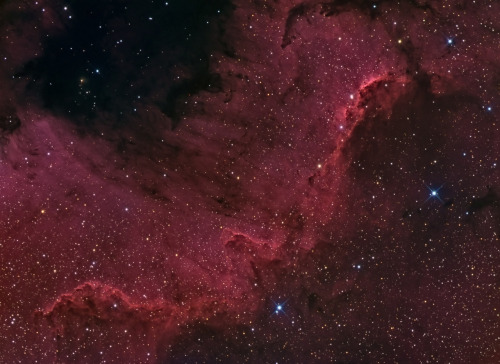Spiral Galaxy NGC 4911 In The Coma Cluster

Spiral galaxy NGC 4911 in the Coma Cluster
js
More Posts from Littlecadet-biguniverse and Others

The remnants of a supernova, which usually leaves behind a neutron star. However, no such x-rays have been discovered. Could this be the youngest black hole in the milky way?

Juno Arrives at Jupiter Today!
Today on the 4th of July, 2016 (barring any tragic occurrence with the engine firing) NASA’s Juno spacecraft will enter into orbit around Jupiter.
It’s been traveling since 2011 and carries thick shielding to protect its instruments from the dangerous fields of radiation surrounding the planet.
Juno’s not the first spacecraft to go to Jupiter, but it will be the closest. I like to imagine that Juno will look like a scene from Alien: Isolation where you get to look out the window and see that massive gas giant below you.
The goals of this mission are essentially thus: investigate the weather, atmosphere and magnetosphere on Jupiter.
Moving into a grander context, as answers start to come in and we learn more about Jupiter’s nature we hope to learn more about the questions we must be asking in order to investigate the formation of our very solar system on a deeper level.
Of course with any luck and a lot of hard work, we will be able to build a more harmonious theory of how a star system forms, and the things that go into the construct of a massive gas giant.
(Image credit: NASA and JPL)

Milky Way from Lake Cuyamaca js


Wings of a butterfly nebula.
Image Credit: Hubble Legacy Archive, NASA, ESA - Processing: Judy Schmidt

M8 // Lagoon Nebula (left of center) & M20 // The Trifid (bottom)

TODAY IN HISTORY: The spectacular rings of Saturn, August 23, 1981, observed by the Voyager 2 space probe.


MARTIAN STORMS - Seen in 1977 by the Viking 2 Orbiter
“Like its predecessor, the Viking 2 mission consisted of a lander and an orbiter designed to take high-resolution images, and study the Martian surface and atmosphere. Both the Viking 1 and 2 landers benefited greatly from their orbiting counterparts, which snapped images that helped mission controllers navigate the landers to safe landing sites.”
This particular image was taken by the Viking 2 Orbiter and shows a massive dust storm on the red planet. This spectacular storm can be seen on a global scale. The Viking 2 mission would end 3 years later on April 11, 1980.
Credit: NASA/JPL

Southern NGC7000
js
-
 narutogudiofwo-blog liked this · 6 years ago
narutogudiofwo-blog liked this · 6 years ago -
 daemondamian liked this · 6 years ago
daemondamian liked this · 6 years ago -
 thedoctorsawkwardhufflepuff liked this · 6 years ago
thedoctorsawkwardhufflepuff liked this · 6 years ago -
 genocider-syo-is-still-my-queen liked this · 6 years ago
genocider-syo-is-still-my-queen liked this · 6 years ago -
 ajc18615425 liked this · 6 years ago
ajc18615425 liked this · 6 years ago -
 dani-glz-maltes liked this · 6 years ago
dani-glz-maltes liked this · 6 years ago -
 oorts-and-clouds reblogged this · 6 years ago
oorts-and-clouds reblogged this · 6 years ago -
 caesarino-zeppeli liked this · 6 years ago
caesarino-zeppeli liked this · 6 years ago -
 andrew-barrera reblogged this · 6 years ago
andrew-barrera reblogged this · 6 years ago -
 amandathescarlet liked this · 6 years ago
amandathescarlet liked this · 6 years ago -
 diosita-de-la-lluvia liked this · 6 years ago
diosita-de-la-lluvia liked this · 6 years ago -
 i-s-d-m-8 liked this · 6 years ago
i-s-d-m-8 liked this · 6 years ago -
 generalblazeavenue liked this · 6 years ago
generalblazeavenue liked this · 6 years ago -
 y-oh-y reblogged this · 6 years ago
y-oh-y reblogged this · 6 years ago -
 athena-2 liked this · 7 years ago
athena-2 liked this · 7 years ago -
 tezxochipilli liked this · 8 years ago
tezxochipilli liked this · 8 years ago -
 wonderland-of-oddities reblogged this · 8 years ago
wonderland-of-oddities reblogged this · 8 years ago -
 thephilosopherisstoned reblogged this · 8 years ago
thephilosopherisstoned reblogged this · 8 years ago -
 irrigatie reblogged this · 8 years ago
irrigatie reblogged this · 8 years ago -
 treinmeisje liked this · 8 years ago
treinmeisje liked this · 8 years ago -
 sparckydog reblogged this · 8 years ago
sparckydog reblogged this · 8 years ago -
 cyberneticredtinker liked this · 8 years ago
cyberneticredtinker liked this · 8 years ago -
 wheatbee reblogged this · 8 years ago
wheatbee reblogged this · 8 years ago -
 maarohh reblogged this · 8 years ago
maarohh reblogged this · 8 years ago -
 kaertrolde reblogged this · 8 years ago
kaertrolde reblogged this · 8 years ago -
 coldmakerpeach liked this · 8 years ago
coldmakerpeach liked this · 8 years ago -
 starrynightscalm reblogged this · 8 years ago
starrynightscalm reblogged this · 8 years ago -
 wherethewordsdie reblogged this · 8 years ago
wherethewordsdie reblogged this · 8 years ago -
 thirdman000 reblogged this · 8 years ago
thirdman000 reblogged this · 8 years ago -
 samitron reblogged this · 8 years ago
samitron reblogged this · 8 years ago -
 andresnietosilva00 liked this · 8 years ago
andresnietosilva00 liked this · 8 years ago -
 convolutionary reblogged this · 8 years ago
convolutionary reblogged this · 8 years ago -
 lalulutres liked this · 8 years ago
lalulutres liked this · 8 years ago -
 camillefrs reblogged this · 8 years ago
camillefrs reblogged this · 8 years ago -
 despawndense liked this · 8 years ago
despawndense liked this · 8 years ago -
 farharbour reblogged this · 8 years ago
farharbour reblogged this · 8 years ago -
 petebogbody reblogged this · 8 years ago
petebogbody reblogged this · 8 years ago
GREETINGS FROM EARTH! Welcome to my space blog! Let's explore the stars together!!!
144 posts
